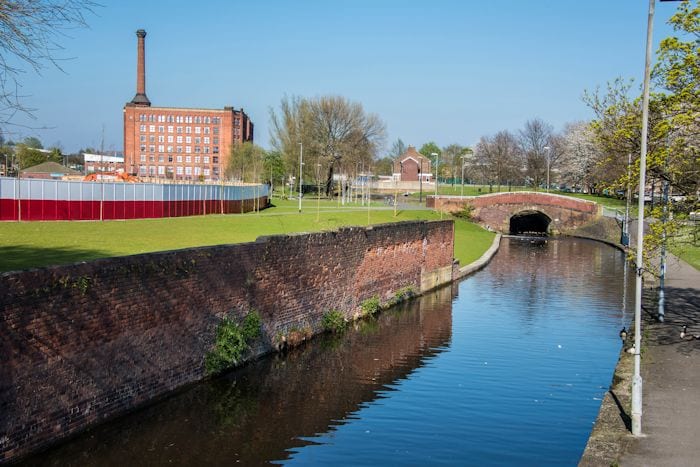Secrets, scandals and underground pubs: the Manchester canals with a murky past
- Written by Dane Hume
- Last updated 8 years ago
- City of Manchester, Community

Greater Manchester’s canals are often havens of tranquility. But there’s more to them than meets the eye.
From discarded waste and bicycles to macabre discoveries such as weapons and dead bodies, the secrets of Manchester’s murky waterways are sometimes revealed.
Now academics from the University of Brighton researching new canal heritage trails in Greater Manchester have revealed forgotten scandals and a hidden underground pub.
One discovery they made was of an entirely underground heritage trail, pointing out the location of underground rivers, canals and even pubs.
Another is an invisible heritage theme which features a 19th century corruption scandal involving sewage and more.
Disposing of waste was a huge problem in the 19th century, given the large and expanding population of Manchester at the time. Despite public programmes to dispose of it safely, in 1885 it was discovered that up to 60 tons of raw sewage was being dumped illegally into the Medlock and Irwell rivers.
It later emerged that a council manager by the name of Henry Whiley was paid a large annual salary plus costs in return for keeping quiet.
At that time, sewage would only have been one of the smells hanging heavy in the air round here. There was smoke, dust and a huge chemical works further along the banks of the Ashton Canal.
The researchers made the discoveries working with local groups to produce three interactive heritage trails for canals in Ancoats, Holt Town and Ashton-under-Lyne as part of their European Waterways Heritages (EuWatHer) project.
They hope their findings will tempt locals to walk the canals and learn to love these under-appreciated parts of Greater Manchester.
The guides are packed with tall tales and interesting stories, including one about George Orwell who, while writing The Road to Wigan Pier, was inspired by the sound of ‘clogged feet clumping over cobbles’ as workers walked to and from work down Every Street.
“We found that Manchester’s heritage development has been dominated by the cotton industry, influencing the design of new buildings and shaping decisions about what to protect and what to demolish,” said Abigail Wincott, one of the researchers.
“This industrial heritage is not always celebratory. Many accounts tell of poverty, exploitation and pollution, but far from addressing social wrongs, these prurient portrayals can end up reinforcing ideas about the majesty and power of rich industrialists and landowners, while the majority of ordinary Mancunians are reduced to a faceless and passive crowd.
“They also reinforce the idea of canals as dirty and industrial, while they actually have a long history as a focus for leisure.
“What we really want is to kick start lots of people in Greater Manchester making and sharing their own canal heritage trails,” said Ms Wincott. “We’ll be going to meet people and demonstrate the apps and try out new walks soon.
“There is some great and much under-appreciated heritage to be explored in Manchester. If we can get local enthusiasts sharing what they know and more people out and about on the canals, then I’ll be happy!”
The trails are available now on the Izi.travel website and mobile app, a platform for travellers which enables users to create audio guides for historical and cultural landmarks across a number of travel destinations. The idea is to make exploring museums and cities even more inspiring and enriching for visitors and travellers alike.
If you’re interested in taking the tour for yourself or you would like to find out more about the EuWatHer project, please visit zi.travel/en or waterwaysexplorer.org
- This article was last updated 8 years ago.
- It was first published on 15 May 2017 and is subject to be updated from time to time. Please refresh or return to see the latest version.
Did we miss something? Let us know: [email protected]
Want to be the first to receive all the latest news stories, what’s on and events from the heart of Manchester? Sign up here.
Manchester is a successful city, but many people suffer. I Love Manchester helps raise awareness and funds to help improve the lives and prospects of people across Greater Manchester – and we can’t do it without your help. So please support us with what you can so we can continue to spread the love. Thank you in advance!
An email you’ll love. Subscribe to our newsletter to get the latest news stories delivered direct to your inbox.
Got a story worth sharing?
What’s the story? We are all ears when it comes to positive news and inspiring stories. You can send story ideas to [email protected]
While we can’t guarantee to publish everything, we will always consider any enquiry or idea that promotes:
- Independent new openings
- Human interest
- Not-for-profit organisations
- Community Interest Companies (CiCs) and projects
- Charities and charitable initiatives
- Affordability and offers saving people over 20%
For anything else, don’t hesitate to get in touch with us about advertorials (from £350+VAT) and advertising opportunities: [email protected]

Almost Famous brings back its most legendary burger – for one month only



The world-renowned Mancunian architect behind Old Trafford’s future

Manchester United reveal plans for new 100,000-seater stadium – set to be UK’s biggest
















